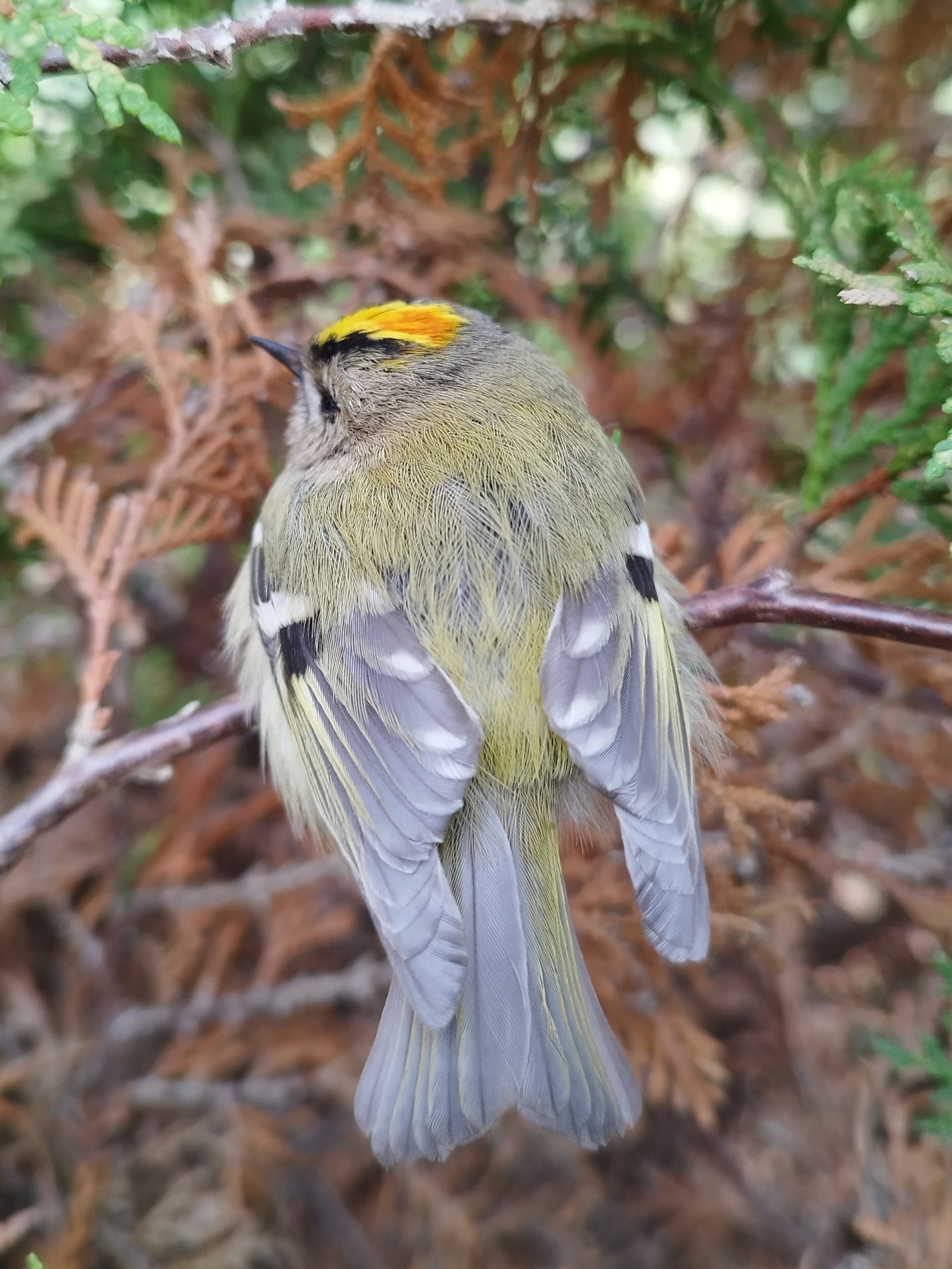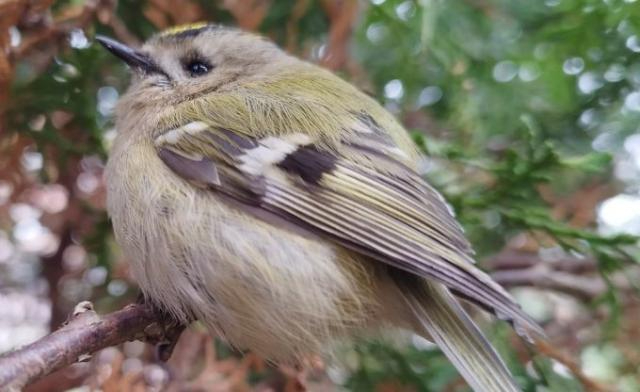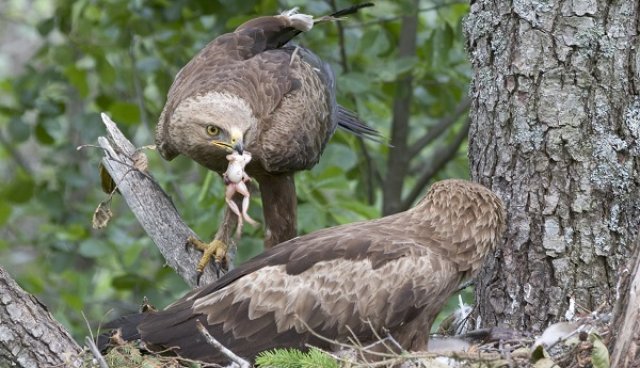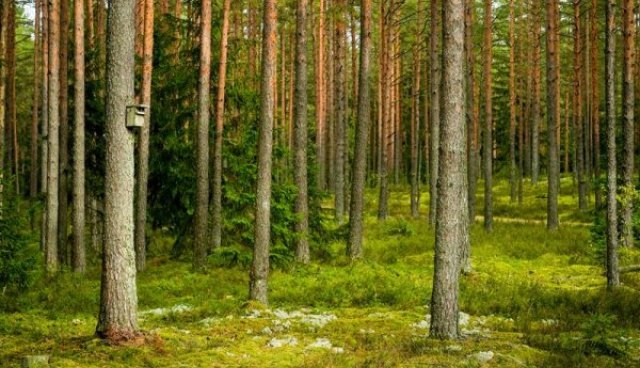In late April or May, pairs of goldcrests build nurseries together to create their first brood. The goldfinches are the smallest bird not only in Latvia, but in all of Europe, and they live in forests. The various sounds they make are more often heard in winter, but those who are more attentive in nature can also try to catch the voice of the tiny bird during the warm season when the male bird sings a quiet roosting song. Naturalist Ilmārs Tīrmanis introduces us to this unusual little bird.
Another winter has passed – the time of year when delicate, high-pitched calls of tsī-tsī-tsī, tsī-tsī-tsī can often be heard in the forests. The songs originate from a tiny ball of olive-green feathers – the goldcrest Regulus regulus. During the cold season, it is often spotted when rapidly flapping its small wings like a butterfly, it burrows into a tangle of spruce branches. Struggling and fidgeting behind the cover of the needles keeps him constantly busy. As agile as mercury – it looks for food! Sometimes in winter, in search of food, it also tends to briefly descend to the ground. It feeds on small insects and other small invertebrates.
Nine centimeters and seven grams
The forest is the main habitat of the goldcrest. However, sometimes in autumn and winter, when in search of food, the bird moves in flocks together with blue tits and often other small birds, it also wanders into the greenery of populated areas and parks, with densely branched woody plants like spruces and cedars.
There is no bird in Latvia smaller than the goldcrest and its rare relative, the common firecrest. Therefore, it can be said that the goldcrest is the smallest representative of the Latvian ornithofauna. When measured from the tip of the pointed beak to the tips of the tail feathers, the goldcrest does not exceed nine centimeters. Short! Of course, the goldcrest is also light – it weighs only five to seven grams. Nowadays, in its small size, this little bird surpasses not only Latvian but all European birds. Perhaps this is why the inhabitants of the microstate of Luxembourg have chosen this tiny species as their national bird.

A secret sign of sexual differentiation
The most striking visual sign of the goldcrest is a wide, bright yellow stripe running lengthwise across the middle of the head. When the animal is worried, it tends to fluff up the feathers of this stripe, forming a small crest. On each side of the yellow “crown”, a narrow black border runs along the edge.
Compared to the head, the rest of the goldcrest’s plumage is quite modest: the upper body is light moss-green in the front, gradually becoming olive-green, the wings are noticeably darker and grayer, with two white transverse stripes, and the belly is pale gray-yellow or greenish-white.
It is almost impossible to determine the sex of the bird from a distance. Only by holding the bird in your hands and patting the top of its head can you notice the significant difference – in the male, the feathers forming the yellow band are colored orange at the bottom. But if the feathers turn out to be yellow all the way to the base, it is clear that it is a female.
A nimble acrobat
Regardless of the sex, the goldcrest is a nimble acrobat. Looking for food, it not only quickly runs along the trunk of a tree, and jumps from branch to branch, but often even hangs on its hind legs. In addition, it can and does flutter in the air on the spot.
The bird constantly directs its brown eyes between the fir needles, into the cracks of the wood or bark, into the chips, it sniffs and examines the clumps of lichen and moss growing on the branches of trees, always carefully searches all the old nests of other birds and squirrels it has encountered. In search of food, it sometimes briefly descends to the ground in winter.
The quiet song of the rut
It is much more difficult to detect the presence of these small birds in the warm season than in the cold period of the year. Practically all day long – from early morning until late evening – goldcrests live relatively hidden from human eyes, staying at higher altitudes, mainly in fir trees, where they look for food – insect larvae and eggs, small insects. Even if a potential meal escapes by running away, the goldcrests are eager to catch it, regardless of whether the food is running or jumping between the fir needles. When necessary, he – as a member of the flycatcher family – is very adept at chasing a fugitive flying in the air.
A more observant nature explorer may manage to catch the male goldcrest’s dry rutting period song in the forest during the warm season, as the song is quiet but distinguishable. Bird researchers often say that it resembles the sound that could be made by pulling a small, squeaky cart. Of course, the bird dedicates this song not to a human, but to the goldcrests. But singing is not the only thing the goldcrest does during the rutting period. The male also demonstrates his special masculine beauty to the chosen female, by folding the “golden” feathers of his head, thus revealing their orange undersides to the gaze of the object of adoration.
Eggs the size of a pea
Having formed a couple, in late April or May, both partners jointly build a nursery to create the first group of offspring of the season. In the middle of a tall spruce, on the underside of a thick branch, far from the trunk, in a thicket of fir needles, they build a round nest from fine spruce branches, thin stems of various herbs and ferns, and tiny mosses and lichens, leaving a gap for the entrance in the roof. From the inside, the nest is lined with animal wool with bird feathers.
Soon after, the female lays eight to ten pale pink, matte, pea-sized eggs, covered in tiny brownish specks at the thickest end, in the nest and sits down to incubate. While she sits, her partner continuously provides the brooder with food from dawn to dusk. After about two weeks of incubation, small chicks hatch from the small eggs. The female warms them for about a week, whereas the male diligently provides the family with food. When the chicks have grown a little, the female also begins to leave the nest to join the male. Both parents feed the chicks for another week, and then the youngsters leave the nest. While they learn to be independent, the offspring receives food from the father and mother's beak for some time after they have left the nest.
Adult birds usually start building a new nest shortly after raising their first brood, as most Latvian goldcrests have two broods per season.


